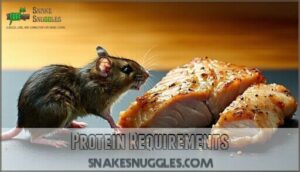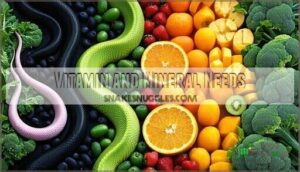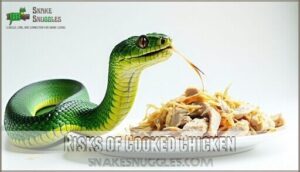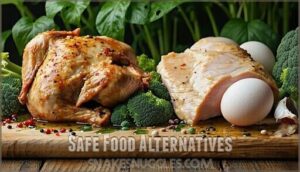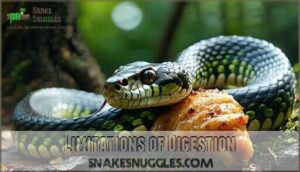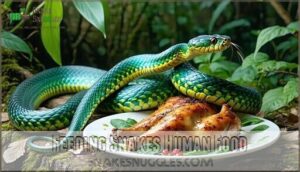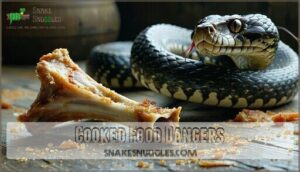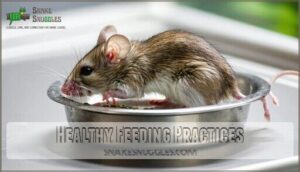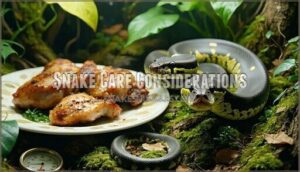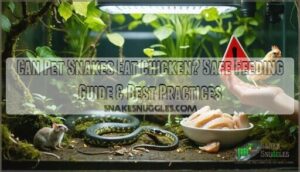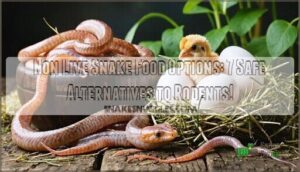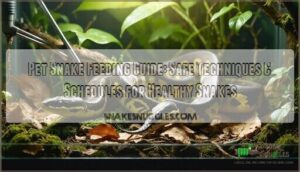This site is supported by our readers. We may earn a commission, at no cost to you, if you purchase through links.
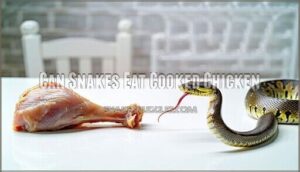
Cooking destroys essential nutrients snakes need and can introduce harmful bacteria from seasonings or preparation methods. Your snake’s digestive system evolved to process raw prey, not processed foods.
Cooked meat also lacks the complete nutritional profile found in whole prey animals. Instead, stick to appropriate frozen-thawed rodents or other raw prey items specifically designed for reptiles.
The cooking process fundamentally changes the food’s structure in ways that don’t align with your snake’s biological needs and dietary requirements.
Table Of Contents
Key Takeaways
- Don’t feed your snake cooked chicken – it destroys essential nutrients, makes bones brittle and dangerous, and can cause choking hazards or internal injuries that could harm your pet.
- Your snake’s digestive system isn’t designed for cooked food – it evolved to process raw prey with specific enzymes and acids that work best with uncooked meat, bones, and organs.
- Cooked chicken creates serious nutritional deficiencies – the cooking process eliminates vital vitamins, minerals, and amino acids your snake needs, leading to health problems over time.
- Stick to frozen-thawed rodents or appropriate raw prey – these provide complete nutrition that matches your snake’s natural diet and eliminate the risks associated with processed foods.
Snakes Eating Habits
Understanding your snake’s natural eating habits will help you make better feeding decisions for their health and safety.
Snakes have evolved as strict carnivores that consume raw prey whole, including rodents, birds, eggs, and insects in their natural habitat.
Natural Diet Composition
Every snake species has evolved specific dietary adaptations that reflect their natural food chains and carnivorous requirements.
Your pet snake’s evolutionary diet includes rodents, birds, eggs, and insects – all consumed raw and whole.
Understanding what snakes eat in the wild helps you recognize their unique snake nutrition needs and feeding habits, which differ dramatically from processed human food, highlighting the importance of their natural and raw diet.
Importance of Raw Food
Your snake’s digestive system thrives on raw food because it’s perfectly designed for this natural state.
Raw meat preserves essential enzymes and delivers ideal nutrients that cooking destroys, simulating wild conditions your pet needs.
Here’s why raw food matters for snake nutrition:
- Enzyme Preservation – Raw meat maintains digestive enzymes that aid natural digestion
- Optimal Nutrients – Vitamins and minerals stay intact without heat damage
- Wild Simulation – Mimics your snake’s natural hunting and feeding patterns
- Avoiding Additives – No harmful preservatives or cooking chemicals enter their system
- Natural Digestion – Snake digestive systems evolved specifically for processing raw prey
Can Snakes Eat Cooked Chicken
No, you shouldn’t feed your snake cooked chicken. While cooking benefits human food safety by eliminating harmful bacteria, it creates serious problems for your scaly friend’s health.
The cooking process destroys essential nutrients that snakes need from their prey, and it makes bones dangerously brittle. These cooked bones can splinter and cause choking hazards or internal injuries.
Palatability concerns also arise since snakes naturally prefer raw food that mimics their wild diet. Your snake might simply refuse cooked chicken because it doesn’t recognize it as proper food.
From a cost analysis perspective, safe snake food like frozen rodents provides better nutritional value than expensive alternative proteins that lack essential vitamins. Snake preferences lean heavily toward whole prey animals that offer complete nutrition.
Cooked chicken fails to meet these snake diet requirements, making it an unsuitable choice for responsible snake feeding practices. Notably, bacterial contamination is a risk when feeding snakes chicken.
Snake Nutrition Basics
Your snake’s body needs specific nutrients to stay healthy, and understanding these requirements helps you make better feeding choices.
Snakes require complete proteins with essential amino acids, plus vitamins A, D3, and B-complex, along with calcium and phosphorus in proper ratios for strong bones and proper muscle function, which involves essential amino acids.
Protein Requirements
Understanding your snake’s protein requirements isn’t rocket science, but it’s vital for their health.
Snakes need complete amino acids from whole prey for proper muscle development across different growth stages.
Here’s what matters most:
- Complete protein sources – whole rodents provide all essential amino acids
- High digestibility factors – raw prey digests easier than cooked chicken
- Species-specific nutritional requirements – larger snakes need more lean protein
Cooked chicken lacks these complete protein profiles your snake desperately needs.
Vitamin and Mineral Needs
Your snake’s body relies on essential vitamins and minerals to thrive, yet many owners overlook these critical nutritional requirements.
Without proper dietary balance, mineral deficiencies can develop quickly, leading to serious health complications that supplements alone can’t fix.
| Essential Vitamins | Key Functions |
|---|---|
| Vitamin D3 | Calcium absorption, bone health |
| Vitamin A | Vision, immune system support |
| B-Complex Vitamins | Metabolism, nervous system function |
| Vitamin E | Antioxidant protection, reproduction |
Whole prey animals provide these nutrients naturally, making them superior nutritional sources compared to processed alternatives that lack complete dietary balance.
Risks of Cooked Chicken
While cooked chicken might seem like a convenient feeding option, it actually poses serious health risks that could harm your snake.
The cooking process destroys essential nutrients your snake needs and creates dangerous bacterial contamination that can lead to severe digestive problems.
Bacterial Contamination
When you handle chicken for snake food, you’re playing with bacterial fire that could burn your pet.
Raw chicken carries Salmonella risk and E. coli exposure that overwhelm your snake’s natural defenses, unlike properly frozen prey.
Even with strict hygiene practices, infection prevention becomes nearly impossible when dealing with contaminated poultry designed for human consumption rather than reptile feeding, posing a significant threat to your pet’s health due to E. coli exposure.
Nutrient Destruction
Cooking’s impact on chicken devastates the nutrients your snake needs.
Heat destroys essential enzymes and causes protein denaturation, making the meat harder to digest.
Vitamin degradation occurs rapidly during cooking, while mineral bioavailability decreases substantially, leading to nutritional deficiencies that can seriously harm your pet’s health over time.
Safe Food Alternatives
If you want to keep your snake healthy, you’ll need to offer foods that match what they’d eat in the wild, like raw rodents, eggs, or unprocessed meats.
Sticking to these safe alternatives helps your snake get the nutrients it needs, and saves you from a surprise trip to the vet.
Raw Meat Options
If cooked chicken sounds risky thanks to salmonella and bacterial contamination, raw meat is a safer bet for your snake.
You can offer Beef and Pork, Fish Variety, and different Poultry Types, but always choose high Meat Quality.
Some keepers use Hybrid Diets, mixing raw meat and fish.
Just remember, snakes need their food raw—never seasoned or processed.
To guarantee a balanced diet, consider feeding snakes whole prey options.
Egg Feeding
After exploring raw meat options, eggs offer a unique twist for your snake diet.
Quail eggs are a favorite due to their small egg size and manageable shell thickness, making egg digestion easier.
Egg variety matters—finch, budgie, and canary eggs suit smaller snakes.
Remember, only certain species handle eggs well, and poultry eggs provide different nutrients for snake nutrition requirements.
Larger snakes, however, can consume coturnix quail eggs.
Snake Digestive System
Your snake’s digestive system evolved specifically to process raw meat, bones, and organs from whole prey animals.
When you feed cooked chicken, you’re working against millions of years of evolutionary adaptation that designed their stomachs to handle raw food with powerful enzymes and acids, which is a result of evolutionary adaptation.
Adaptation to Raw Food
Your snake’s digestive system evolved over millions of years to process raw meat with remarkable efficiency.
Their specialized enzyme production breaks down proteins, bones, and organs from whole prey animals, while their unique gut microbiome thrives on uncooked food sources.
Here’s what makes their raw diet adaptation so powerful:
- Enzyme production works at peak efficiency with raw meat and poultry nutrients
- Prey digestion occurs naturally through evolutionary advantages developed over millennia
- Raw diet benefits include ideal nutrient absorption and healthy gut bacteria
Limitations of Digestion
Your snake’s digestive system can’t handle cooked chicken because cooking destroys essential enzyme production pathways.
Unlike humans, snakes lack specialized mechanisms for bone digestion from processed foods, and they absolutely can’t process plant matter.
Cooking effects fundamentally alter protein structures, making waste elimination difficult and causing severe digestive issues that compromise your pet’s health completely, which can be attributed to the fact that cooking destroys essential enzyme production pathways, leading to difficult waste elimination, and ultimately resulting in health problems.
Feeding Snakes Human Food
You might think sharing your dinner with your snake is a fun idea, but not all human foods are safe for these reptiles.
It’s important to know which ingredients can meet their nutritional needs and which ones could cause serious health problems.
Suitable Human Foods
While your snake’s digestive system handles raw foods naturally, you’ll want to know which human foods won’t harm your pet.
Only specific raw options work safely for emergency feeding situations.
Here are the only suitable human foods for snakes:
- Raw Meat – Fresh, unseasoned chicken or turkey pieces (emergency only)
- Eggs Benefits – Plain raw eggs for occasional variety in egg-eating species
- Fish Options – Freshly killed fish for water snake species (not goldfish)
- Beef Choices – Raw, unprocessed beef for larger snake species
These safe foods for snakes must stay completely raw and additive-free.
Avoiding Harmful Foods
While certain raw human foods work for snakes, many others pose serious risks.
Toxic Fish like goldfish and mackerel can poison your pet, while any Spice Dangers from seasoned meats cause digestive damage.
Fruit Avoidance is critical since snakes can’t process plant matter.
Processed Meats contain harmful additives.
Remember to avoid poor prey quality to guarantee proper nutrition.
Focus on Safe Alternatives like frozen rodents instead of risky options, and prioritize Fruit Avoidance and beware of Toxic Fish.
Cooked Food Dangers
Cooked chicken presents serious risks that you can’t ignore when feeding your snake.
The cooking process destroys essential nutrients and makes bones brittle, creating dangerous choking hazards that could harm or kill your pet, which is a serious risk.
Choking Hazards
When cooked chicken’s brittle bones break into sharp fragments, they create deadly choking hazards that can lodge in your snake’s throat or digestive tract.
Your pet’s swallowing reflex can’t detect these dangerous pieces, making proper food preparation essential for snake health.
Understanding snake anatomy helps you recognize why prevention methods focusing on appropriate bone size matter so much for safe snake digestion.
Nutrient Deficiencies
Beyond choking risks, cooked chicken creates serious nutritional deficiencies that’ll wreck your snake’s health.
Heat destroys essential nutrients, leaving your pet malnourished despite regular feeding.
- Calcium Imbalance – boneless chicken can’t provide proper calcium-phosphorus ratios
- Vitamin Deficiencies – cooking destroys B vitamins and taurine needed for heart function
- Mineral Absorption issues from missing organ meats and bone content
- Protein Deficiency occurs when heat denatures amino acid profiles
- Supplementation Risks increase since artificial vitamins can’t replace whole prey nutrition
Healthy Feeding Practices
You’ll want to focus on proper prey selection and safe preparation methods when feeding your snake.
Raw, appropriately-sized rodents provide complete nutrition, while careful thawing and handling prevent bacterial contamination that could harm your pet.
Choosing Raw Prey
With frozen options being your best bet, you’ll want to prioritize prey size that matches your snake’s width.
Ethical sourcing from reputable suppliers guarantees nutritional balance while preventing feeding snakes contaminated food.
Consider prey variety to avoid nutritional deficiencies in your reptile diet.
To guarantee a healthy diet, consider prey thawing techniques before feeding.
| Prey Type | Benefits | Considerations |
|---|---|---|
| Frozen Rodents | Complete nutrition, parasite-free | Match snake’s body width |
| Raw Chicken | Protein source, cost-effective | Requires supplements |
| Quail Eggs | Easy digestion, natural choice | Size appropriate for species |
Preparing Food Safely
Proper preparation transforms your snake’s mealtime from risky business into safe dining.
You’ll want to master thawing methods, safe handling, and hygiene practices to prevent Salmonella and bacteria from turning dinner deadly.
- Thawing Methods: Defrost frozen prey in your refrigerator overnight, never at room temperature where bacteria multiply rapidly
- Safe Handling: Wash hands thoroughly before and after food preparation, disinfecting surfaces to prevent cross-contamination
- Storage Guidelines: Keep frozen rodents sealed and dated, following portion control based on your snake’s size requirements.
Consider proper rodent containers for ideal freshness.
Snake Care Considerations
When caring for your snake, you’ll need to understand that each species has unique dietary requirements that can’t be met with cooked chicken or other processed foods.
Making common feeding mistakes like offering cooked meat can lead to serious health problems, so it’s vital to research your specific snake’s natural diet and stick to appropriate raw prey options, which involves understanding the natural diet.
Species-Specific Diets
Your snake’s dietary variations depend entirely on its species.
Ball pythons thrive on rodents, while garter snakes need fish and amphibians.
Prey size should match your snake’s girth, and feeding frequency varies by age and species.
Understanding wild diets prevents nutritional deficiencies – corn snakes naturally eat eggs and small mammals, not chicken.
Species-specific diets guarantee proper nutritional needs are met for peak health.
Many owners buy specialized reptile food for their snakes.
Avoiding Common Mistakes
Don’t fall into these traps when feeding your snake. Overfeeding risks obesity and regurgitation, while improper thawing breeds bacteria.
Supplement overuse can’t fix a poor snake diet – whole prey provides complete nutrition. Ignoring species needs leads to nutritional deficiencies.
Unhygienic handling spreads salmonella and other nasties. Remember, cooked chicken poses serious risks your scaly friend doesn’t deserve.
To reduce stress, consider approaching snakes cautiously. This will help prevent regurgitation and ensure a healthy environment for your pet, avoiding nutritional deficiencies.
Frequently Asked Questions (FAQs)
What snake can eat a chicken?
Roughly 75% of python species can consume whole chickens once they reach maturity.
You’ll find that large constrictors like Burmese pythons, reticulated pythons, African rock pythons, and anacondas regularly tackle chicken-sized prey in the wild.
What should you not feed a snake?
Don’t feed your snake cooked, processed, or seasoned foods, fruits, vegetables, spices, herbs, or toxic fish like goldfish and shellfish. Stick to raw, whole prey items for superior health.
What are snakes not allowed to eat?
Back when knights rode horses instead of cars, you shouldn’t feed snakes cooked foods, processed meats, fruits, vegetables, spices, or seasoned items. They’re carnivores needing raw prey like rodents.
How often should pet snakes be fed?
Most adult snakes eat every 1-2 weeks, while juveniles need weekly feedings. You’ll adjust frequency based on your snake’s age, size, and species-specific needs for ideal health.
What temperature should snake food be served?
Serve snake food at room temperature, around 70-75°F.
You’ll want to thaw frozen prey in the refrigerator overnight, then let it warm to room temperature before offering it to your snake.
Can snakes eat frozen then thawed rodents?
Yes, you can absolutely feed your snake frozen-then-thawed rodents. They’re actually safer than live prey, eliminating bite risks while maintaining nutritional value. Thaw them overnight in your refrigerator first.
How do you know if snake refuses food?
Like a stubborn diner pushing away their plate, your snake shows clear signs when rejecting food.
They’ll ignore prey, turn away, hiss defensively, or simply refuse to strike at offered meals consistently, which can be a clear indication that they are rejecting food.
What size prey should snakes eat?
Choose prey that’s roughly the same width as your snake’s thickest body section. You’ll want something they can swallow comfortably without struggling – think "snug fit, not tight squeeze.
Conclusion
Last month, a ball python owner rushed their pet to an emergency vet after feeding cooked chicken seasoned with garlic powder, resulting in severe digestive distress and dehydration.
Remember, can snakes eat cooked chicken isn’t the right question—it’s whether they should.
Your snake’s health depends on proper nutrition from whole prey animals.
Cooking destroys essential nutrients and creates unnecessary risks.
Stick to frozen-thawed rodents designed for reptiles.
Your snake’s digestive system evolved for raw food, not processed meals from your kitchen.

